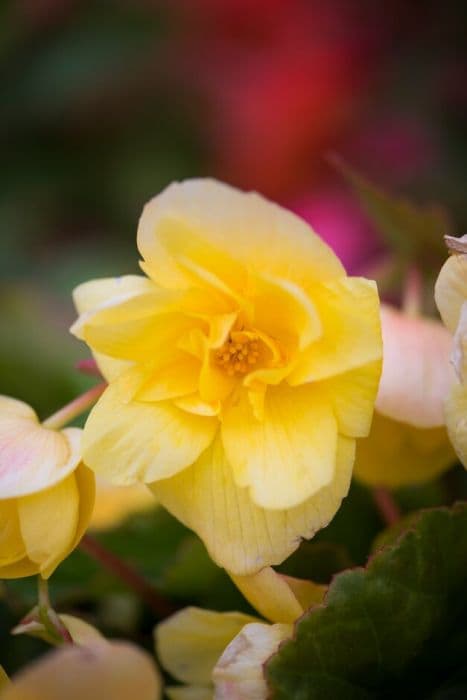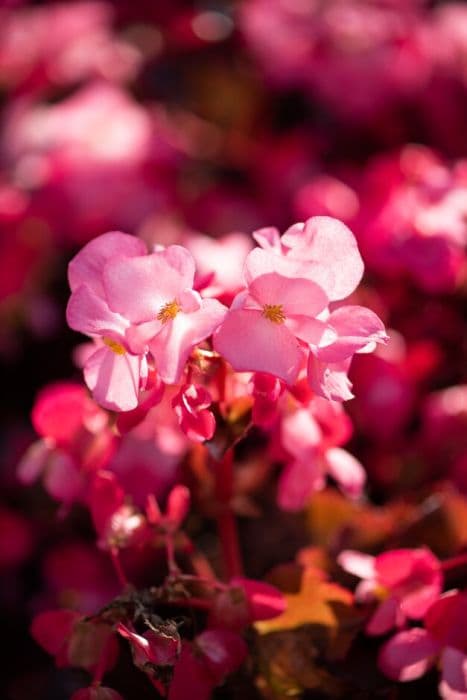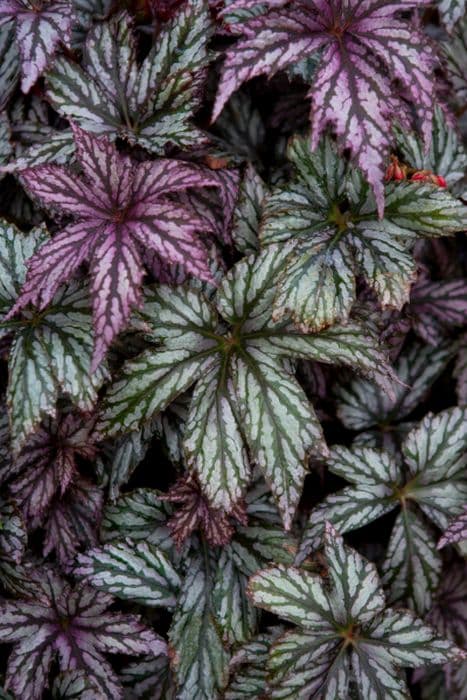Wax Begonia Begonia 'Ricky Minter'

ABOUT
The Begonia 'Ricky Minter' displays a striking appearance with its foliage and blooms. Its leaves are typically a lush green, with some varieties showcasing a reddish or purplish underside, adding a dramatic contrast. The shape of the leaves can vary but often includes a mixture of asymmetry and jagged edges, which further enhances its ornamental appeal. During its blooming season, the plant produces clusters of flowers that come in a range of colors, from soft pinks to bold reds, sometimes with additional hues that create a gradient effect on the petals. Overall, the Begonia 'Ricky Minter' is cherished for its distinctive leaf patterns and vibrant floral displays which make it a popular choice among gardeners and houseplant enthusiasts for adding a lively touch to their plant collections.
About this plant
 Names
NamesSynonyms
Ricky Minter Begonia
Common names
Begonia 'Ricky Minter'.
 Toxicity
ToxicityTo humans
Begonias, including the Begonia 'Ricky Minter', contain compounds that can be toxic to humans if ingested. They have insoluble oxalates which, when chewed or swallowed, can cause a burning sensation in the mouth, tongue, and throat, as well as difficulty swallowing. In severe cases, gastrointestinal symptoms like nausea, vomiting, and diarrhea may occur. It is generally advised to avoid ingesting any part of begonias.
To pets
Begonias are toxic to pets, as they contain insoluble oxalates that can cause irritation and burning of the mouth, tongue, and lips in animals upon ingestion. They may also experience difficulty swallowing, drooling, vomiting, and in more severe cases, may show signs of asphyxiation due to swelling of the airways. It is important to prevent pets from chewing on or consuming any part of a begonia plant.
 Characteristics
CharacteristicsLife cycle
Perennials
Foliage type
Evergreen
Color of leaves
Mixed
Flower color
Pink
Height
1 foot (0.3 meters)
Spread
1 foot (0.3 meters)
Plant type
Herb
Hardiness zones
10
Native area
Tropical South America
Benefits
 General Benefits
General Benefits- Decorative Appeal: Begonia 'Ricky Minter' offers a visually striking addition to any garden or indoor space with its unique foliage and flowers.
- Low Maintenance: This plant typically requires little care, thriving with basic watering, occasional feeding, and partial shade.
- Year-Round Interest: Depending on the climate, Begonia 'Ricky Minter' can provide year-round foliage and, in some cases, flowers to brighten the garden.
- Suitable for Containers: This plant's adaptable nature makes it suitable for growing in pots, hanging baskets, or other containers, providing flexibility in garden design.
- Shade Tolerance: It can grow in areas with partial sun to shade, making it an excellent choice for darker parts of the garden where other plants might struggle.
- Attracts Pollinators: Flowering begonias can attract bees and other pollinators to your garden, supporting local ecosystems.
- Non-Invasive: Begonia 'Ricky Minter' does not typically invade surrounding areas, which helps to maintain garden design and reduces maintenance.
 Medical Properties
Medical PropertiesThis plant is not used for medical purposes.
 Air-purifying Qualities
Air-purifying QualitiesThis plant is not specifically known for air purifying qualities.
 Other Uses
Other Uses- Edible Decor: The leaves of Begonia 'Ricky Minter' can be used to add a vibrant, colorful garnish to dishes, especially desserts and salads, due to their ornamental appearance.
- Aquariums: Some aquarists use begonia leaves to provide natural cover for small fish and invertebrates when submerged in aquariums.
- Crafting: The unique patterns of the leaves can be used in decoupage projects, to create interesting textures and designs on various surfaces.
- Education: The plant can be used as an educational tool to teach about hybridization and the cultivation of ornamental plants.
- Bioindicators: The Begonia 'Ricky Minter' might be used as a bioindicator to monitor environmental conditions in a greenhouse, as their growth and health can reflect humidity and light levels.
- Photography Subject: The attractive foliage and flowers make Begonia 'Ricky Minter' an excellent subject for botanical photography and illustration.
- Natural Confetti: Dried leaves and petals can be used as biodegradable confetti for eco-friendly celebrations.
- Book Pressing: Leaves from Begonia 'Ricky Minter' can be used in book pressing crafts to create intricate leaf prints on paper goods.
- Soil Health Indicator: The plant’s response to soil conditions can help gardeners assess the health of their garden soil based on the visible condition of the plant.
- Jewelry Making: Transparent leaves or petals of the Begonia 'Ricky Minter' can be preserved in resin to create unique, botanical pieces of jewelry.
Interesting Facts
 Feng Shui
Feng ShuiThe Begonia is not used in Feng Shui practice.
 Zodiac Sign Compitability
Zodiac Sign CompitabilityThe Begonia is not used in astrology practice.
 Plant Symbolism
Plant Symbolism- Caution: Begonias, in general, symbolize a warning to be cautious or to beware, which could relate to new situations or relationships in one's life.
- Harmony: They can also represent a sense of balance and peace, encouraging an environment where different elements come together harmoniously.
- Individuality: Begonias stand for uniqueness due to their varied and distinct flower shapes and colors, celebrating the beauty in being different.
- Deep Thoughts: With their rich and intricate blooms, they may prompt introspection or symbolize deep thinking and contemplation.
 Water
WaterFor the Begonia 'Ricky Minter', commonly known as Wax Begonia, it's important to maintain even moisture without overwatering. Water the Wax Begonia when the top inch of soil feels dry to the touch, which is typically once a week, but this may vary depending on environmental conditions. Use room temperature water and gently water at the base of the plant to avoid wetting the foliage, which can lead to fungal diseases. Approximately 8 to 16 ounces of water should be enough each time, adjusted for the size of the plant and pot.
 Light
LightThe Wax Begonia thrives in bright, indirect sunlight. A spot near an east-facing window where it can receive morning light or filtered light through a sheer curtain is ideal. Avoid exposing the Wax Begonia to direct midday sun, which can scorch the leaves and cause damage.
 Temperature
TemperatureWax Begonias prefer a warm climate with temperatures ranging from 60 to 75 degrees Fahrenheit. They should not be exposed to temperatures below 50 degrees, as cold can damage the plant. Ideal growth is achieved within this temperature range, avoiding drafts and sudden temperature changes.
 Pruning
PruningPruning Wax Begonias encourages bushier growth and removes any leggy or dead stems. Lightly trim the plant throughout the growing season as needed, and perform a more thorough pruning in the spring to stimulate new growth. Always use clean, sharp scissors or pruning shears to make clean cuts.
 Cleaning
CleaningAs needed
 Soil
SoilBegonias like 'Ricky Minter' thrive in a well-draining soil mix, consisting of peat moss, perlite, and pine bark fines in equal parts. The soil pH should be slightly acidic to neutral, ranging from 5.5 to 6.5 for optimal growth.
 Repotting
Repotting‘Ricky Minter’ Begonias should be repotted every 1 to 2 years or when they outgrow their current pot, typically in the spring or early summer before the growing season.
 Humidity & Misting
Humidity & Misting'Ricky Minter' Begonias prefer high humidity levels, around 50-60%, which is crucial for their growth and overall health.
 Suitable locations
Suitable locationsIndoor
Place in bright, indirect light, and maintain high humidity.
Outdoor
Partial shade, shelter from wind, and consistent moisture are ideal.
Hardiness zone
10-11 USDA
 Life cycle
Life cycleThe life of a Begonia 'Ricky Minter' begins with seed germination, requiring warm temperatures, consistent moisture, and diffused light. Following germination, the seedling stage involves the development of initial leaves and a rudimentary root system. As it enters the juvenile stage, the plant experiences rapid growth and the formation of a more established stem and a greater number of leaves. The maturity stage is marked by the plant reaching full size and producing its distinctive flowers, which may happen seasonally depending on climatic conditions. After pollination, the flowers produce seeds, allowing the cycle to continue if the seeds are dispersed and find suitable conditions. The plant may also propagate vegetatively through stem cuttings or leaf petiole cuttings, thus bypassing seed production.
 Propogation
PropogationPropogation time
Spring-Summer
The Begonia 'Ricky Minter', commonly known as a type of Begonia, is typically propagated through leaf cuttings, a method favored for its simplicity and effectiveness. The ideal time to propagate begonias is during the warmer months, from late spring to early summer, when the plant is actively growing. To propagate via leaf cuttings, choose a healthy, mature leaf and cut it into sections, each with a main vein. Lay the sections directly onto moist potting mix, ensuring that the cut veins make good contact with the soil. Over the course of several weeks, with consistent moisture and warmth, new plantlets will form at the sites of the cut veins. These new plantlets can then be gently potted up into individual containers once they've developed a sturdy root system and new leaves.



![Begonia [Bonfire]](/_next/image?url=https%3A%2F%2Fplants-admin.emdemapps.com%2Fimages%2Fplants%2F%2Fimages%2F604b6124363f0.png&w=640&q=75)


![Begonia [Devotion]](/_next/image?url=https%3A%2F%2Fplants-admin.emdemapps.com%2Fimages%2Fplants%2F%2Fimages%2F604b58183573b.png&w=640&q=75)


